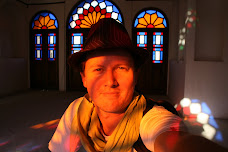A town renowned for its huge water wheels, Hama appeared rather sleepy but a brief reading of its recent history reveals another story – most of the old city was destroyed in a huge battle between government forces and the terrorising Muslim Brotherhood, which some say caused over 3,000 deaths. Despite this, the water wheels are indeed magnificent and produce a continuous loud groaning as they turn. Walking back to our side of town, we stopped to buy one of everything in a chocolate shop, ably helped by Wael Dabbag, a young guy keen to practice his English.
We invited Wael to join us for a tea and nargileh and found a nice table overlooking the Orontes River in the centre of town. We soon found out that not only did he not like the Internet due to its corrupting influences, but was suffering from a broken heart. He had been wooing a girl and had decided to marry her, but had only spoken to her a handful of times. He made his decision based on observing and “testing” her behaviour in the university café and by sending his mother to meet her family. However, it was now all off as he had seen the girl in the company of her “ugly man” cousin and was convinced that she was doing that to taunt him and that just wasn’t on. Great banter all round.
Around Hama:
Apamea – a medium size desert granite city constructed on wild, grassy moor overlooking the Al-Ghab plain. Apamea was founded in 2nd century BC by Seleucus I, one of Alexander the Great’s generals with inspiring main street flanked by columns, baths, churches and villas. Nearby is the Qala’at al-Mudiq – a medieval castle with tiny village crammed inside.
Crac Des Chevaliers: built in the 12-13th centuries by the Crusaders to defend against the Muslim hoards, this is definitely the most extraordinary and striking castle I have ever seen. The road there winds its way up and around hills and valleys until the huge structure rears up from atop a mountain. The castle must have really sapped the spirits of those Muslim hoards – it has 13 towers and if you managed to cross the moat and penetrate the tall, vertical walls, you would then face the inner castle with separate moat and even thicker walls.
Inside is a complete town with imposing towers and underground baths, chambers, storehouses plus Gothic facades and a church then converted into a mosque. Legend has it they could have held out for years but gave up after only a few months. One cool thing was a local boy singing the azan (call to prayer) under a niche inside the castle walls – brilliant acoustics.
That night we had a rather refined discussion on Dawkins’ ‘The God Delusion’ and much more.
Subscribe to:
Post Comments (Atom)

No comments:
Post a Comment
Note: only a member of this blog may post a comment.